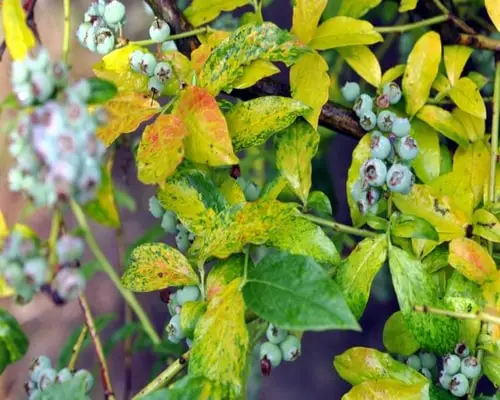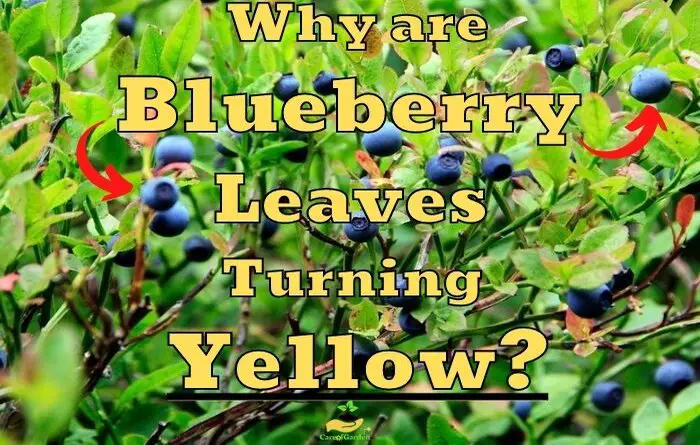5 Surprising Reasons Blueberry Leaves Are Turning Yellow
When you’re looking at blueberry plants, however, there are a few things you need to concern about them. One of these concerns: are my blueberry leaves turning yellow ? And why might that be?
Let’s take a closer look at the reasons blueberry leaves turn yellow, so that you can figure out what’s going on in your garden.
| Why are Blueberry Leaves Turning Yellow: |
|---|
| 1. Too Much or Too Little Water |
| 2. Nutrient Deficiency |
| 3. Incorrect Soil pH |
| 4. Diseases |
| 5. Pests |
1. Too Much or Too Little Water
The most common reasons for yellowing leaves on blueberry plants is an excess or lack of sufficient water. Blueberry plants require regular watering, especially during hot, dry weather. If the soil is allowed to dry out completely, the leaves may turn yellow and even wilt.
Over or under watering is also known as “drought stress” and it can lead to yellowing leaves on your blueberries plants if you are not watering them properly during the growing season (which most homeowners don’t do).
First, let’s take the lack of water which is essential during the formation of the blueberry leaves. When it lacks water, the blueberry will try to conserve it by directing it to the leaves and if there is a period of time when watering is not provided then the leaves will turn yellow and become wilted.
This usually happens when there’s been an extended drought period where no rain has fallen for several weeks at a time.
However, other factors may contribute as well, such as incorrect watering times (too much versus too little) and lack of sunlight, which leads directly into overgrowth issues inside the root zone causing poor nutrients uptake due to poor aeration within these zones.
On the other hand, excess watering (overwatering) will block the capacity of roots to absorb oxygen. Thus the blueberry’s roots are unable to breathe properly because they’re underwater too long and begin to rot. As a result, the blueberry leaves are turning yellow.
When water is not allowed to flow through the soil but collects among the roots, it can not only rot your blueberry bush roots.
It can suffocate them, preventing blueberry to get nutrients.
Treatment
To avoid this, water only when the surface of the soil is dry. You can also rely on the weight of the pot: if it’s too light, it’s time to water and vice versa.
You can also put clay balls and/or small pebbles to facilitate water drainage.
To prevent this from happening, make sure to water your blueberry plants one time per week during the growing seasons, and avoid letting the soil dry out completely.
If your blueberry is planted in a container, make sure there are adequate drainage holes. For blueberries planted in the ground, amend the soil heavily with compost and never leave your blueberries in standing water.
The blueberry must never lack water and the soil around its roots must never be dry.
Be particularly vigilant in summer: water regularly, and in autumn, the season when it prepares for the next fruiting, water its root if the rains are not present.
Finally, prefer rainwater for watering, less calcareous than tap water.
2. Nutrient deficiency
The yellow color of the blueberry leaves is also affected by the lack of nutrients in the soil, which can be caused by environmental factors or an imbalanced diet.
| Nutrient deficiency | Blueberry Symptoms | Treatment |
|---|---|---|
| 1.Nitrogen | The leaves start to yellow and may appear spotted. | Ammonium sulfate or Ammonium nitrate |
| 2.Iron | Young leaves turn yellow near the veins. Over time, the yellowing spreads throughout the all leaves. | Iron sulfate (ferrous sulfate) |
| 3. Zinc | The leaves turn yellow (the entire leaf becomes lemon yellow) and the blueberry stop growing. | Zinc sulfate |
| 4. Manganese | Yellowing appears between the leaf veins. Over time, the yellowed areas begin to die off. | Manganese sulfate |
| 5. Calcium | Young leaves and some of the old ones turn yellow along the edge and curl. | Calcium nitrate |
| 6. Sulfur | The yellowing of young foliage, and only emerging foliage grows already with a yellowish-white color. | Epsom salts or Ammonium sulfate |
Lack of Iron
The most common nutrient deficiency that causes yellow leaves on blueberries is the lack of iron. Iron is primarily used by blueberries plants as iron chelate, which is involved in the formation of chlorophyll and proteins and helps regulate some important processes in plant development.
This iron deficiency called chlorosis, makes photosynthesis impossible and therefore, in the absence of chlorophyll, the blueberry leaves turn yellow.
Potted and indoor plants are particularly affected by chlorosis, as well as plants that are sensitive to lime in the soil and water.
Most often, iron deficiency in blueberries occurs on frequently flooded calcareous soils, the acidity of which exceeds pH 5.5, enriched with phosphorus.
Iron is only available to many plants at a pH value of less than 6 in the soil – this particularly affects rhododendrons.
At a pH above this, no iron could be taken up, even if it were sufficiently available in the soil.
The chlorosis starts on the youngest blueberry leaves and then spreads to the older leaves. In a particularly severe case of leaf yellowing, they fall off over the course of the summer.
Such a weakening of the blueberry plant can have further consequences: reduced growth, restricted flowering or an increased susceptibility to other pathogens.
Treatment
Since it is not a disease, there is no need to carry out treatments, but the problem can be solved simply by restoring iron in the soil, providing iron chelate.
It is also worth checking the pH of the soil, because if it is not acidic enough, the plant can struggle to absorb the useful elements even if they are present in the soil.
The remedy consists in compensating for the iron deficiency when the first yellow leaves appear, which are usually younger and weaker. Iron-based compounds are very common and can be easily found in garden shops.
Fertilizers of “chelated iron” are administered in April by burying them in the ground quickly because sunlight tends to degrade this particular fertilizer.
The chemical composition of these compounds also makes iron available in calcareous soils, i.e. those soils responsible for iron chlorosis, the disease at the base of yellow leaves.
Lack of Nitrogen
With a lack of nitrogen in blueberries, the growth of shoots slows down, and the leaves turn yellowish-green. With a significant deficiency of this element, the leaves of the plant turn yellow.
The lack of nitrogen is most detrimental to the development of the plant, because nitrogen is one of the key elements that blueberries need. Nitrogen is present in proteins, amino acids, many vitamins, chlorophyll, enzymes and nucleic acids that are formed during development in plants.
It should be noted that nitrogen is absorbed by the plant only in the form of ammonium and nitrates, since only this form is the most accessible in the soil.
If there is a lack of nitrogen, the new shoots will also show a reddish discoloration.
An excess of nitrogen is also harmful, in which the shoots continue to grow until late autumn. As a result, they do not have time to lignify and freeze out in winter.
Treatment
To avoid this problem, it’s important to follow the recommended fertilizing schedule for your blueberry plants, and to use a fertilizer specifically designed for blueberry plants.
In order to fix this problem, you need to add more nitrogen (N) fertilizer at least once every week until harvest time.
3. Incorrect Soil pH
Incorrect soil pH affects the blueberry’s ability to receive nutrients. A pH(potential hydrogen) that is too acidic or too alkaline blocks the fertilizing elements contained in the soil as well as the trace elements essential to the good development of the blueberries, which can explain poor growth or yellowing of the leaves.
If the substrate where the plant is planted has a pH incompatible with the needs of the blueberry, iron absorption may be affected and iron chlorosis occurs.
You’ll notice this problem when you check the blueberry leaf, which will start turning yellow, but the vein will remain green.
Unlike other berry bushes, blueberries do not have a main root, but only many small and fibrous processes without hairs. The latter are responsible for plants absorbing water and nutrients from the soil.
For high-growing blueberries, this role is “taken over” by fungal bacteria (mycorrhizal). They grow with the root system of the plant and help with transportation. The peculiarity of these bacteria is that they need acidic soil (Ph 3.5-4.5) to live.
If you plant blueberry seedlings in neutral soil, then the bacteria “fall asleep”. The plant does not receive nutrients, “starvation” is observed, small leaves begin to glow (the first symptom).
Treatment
If you suspect your blueberry plants have a high pH level, there are a few ways to determine if this is the case.
One method is to test your soils pH levels with a kit or other testing device. Another way is to use an indicator plant like willow or red maple trees: if they grow well in your soil, it’s likely acidic; if not, then it may be alkaline (or basic).
PH levels are measured on scales ranging from 0-14: 7 is neutral and 14 is basic (or alkaline). The higher the number of hydrogen ions(pH) in solution, the more acidic it becomes. Therefore, an increase in pH will result in chemical reactions that affect plant growth negatively.
Blueberries are acid-loving plants and do not tolerate neutral or calcareous soil. Their ideal pH is between 4.2 and 5.2. Around pH 4.5 there is the best absorption of the trace elements (Mg, Fe, Zn and Cu).
By lowering the pH of the soil to 4.5, the trace elements iron, manganese and copper become more absorbable for the blueberry plant and yellow leaves are prevented.
The soil pH can be influenced (lowered) by:
- The use of acidifying nitrogen fertilizers. ( Ammonium sulfate)
- Use of organic material with low pH (Peat)
- Addition of water with low pH (Tap water is usually rich in lime)
In this case, try adding more compost or fertilizer around those affected leaves so they can begin growing again!
4. Diseases
In some cases blubbery leaves are turning yellow because of a more serious problem, such as a fungal or bacterial infection.
If you notice that the yellowing is accompanied by other symptoms, such as discoloration, spotting, or wilting, it’s important to seek out the advice of a plant expert for help.
These types of infections can spread quickly and cause significant damage to your blueberry plants, so it’s important to take action as soon as possible.
Blueberry Iron Chlorosis
If the yellow leaves are due to an iron deficiency, the problem is iron chlorosis, a fairly serious but solvable problem. In iron chlorosis, the blueberry leaves initially tend to turn yellow all over their surface, with the exception of the veins, where the chlorophyll is concentrated.
The soil may not be sufficiently acidic for that one plant that seems to be dying. If the soil is not acidic enough (too high a pH), leaf chlorosis (yellowing or yellow-red coloring of the leaves) will occur.
This is followed by a progressive weakening of the plant, the progress of the yellowing and the fall of the leaves. If no action is taken in time, the plant dies.
If the pH (acidity of the soil) is too high, iron (Fe) and sometimes manganese (Mn) deficiency easily arises.
Treatment
Since it is not a disease, there is no need to carry out treatments, but the problem can be solved simply by restoring iron in the soil , providing iron chelates.
It is also worth checking the pH of the soil , because if it is not acidic enough, the plant can struggle to absorb the useful elements even if they are present in the soil.
To remedy the consequences, in the short term, you can purchase iron chelate and possibly a manganese-containing product (chelate or fungicide based on manganese) from a garden center, dissolve it in water and pour it on.
This should return the leaf color to normal green. If you cannot find an iron chelate in your garden center, you can also give it a light fertilization with a special Rhododendron fertilizer that usually also contains iron.
However, fertilizing later than the end of July is disadvantageous because growth continues too long and the plant becomes more susceptible to winter frost.
If you still have a shade net, you can also put it over the bushes for the time being to reduce the suns rays so that things don’t get worse.
Blueberry Mosaic Virus

Tobacco mosaic virus is a disease that spreads like a parasite, gradually infecting the blueberry. It easily exists in completely different regions, since it does not have special preferences in choosing a climate, its distribution occurs easily in any conditions.
The blueberry mosaic virus destroys the ability of the blueberry plant to do photosynthesis, which is an important factor in its life and development. The most obvious sign will be a change in yellow color for the blueberry leaves.
Symptoms are unevenly distributed on infected plants and may not occur every year.
The mosaic spreads slowly in the plantation by unknown means. The vector is believed to be aphids .
Treatment
First of all, the infected blueberry, can no longer be saved, remove it from the site and burn it.
Also, to protect the blueberry crop from the virus, you will have to replace the topsoil. This must be done before spraying.
You can add a few more drops of pharmacy iodine. Use and plant certified virus-free blueberry seeds.
Blueberry Leaf Rust
Blueberry rust is one of the most severe diseases of the blueberry crop. The cause of this disease is the rust fungus Pucciniastrum goeppertianum.
The disease causes chlorotic (yellow) spots on the upper leaf surface of blueberries. These spots later turn reddish brown and may be surrounded by a slight chlorotic halo.
Uredia (a spore-producing body of some rust fungi) are produced on the underside surface of the leaf, appearing as pustules that produce orange-yellow spots.
The pustules soon become visible, scattered over lower leaf surfaces. On severely diseased plants, the leaves may turn brown, curl and fall off.
This defoliation is the main direct cause of damage to the plant, depriving it of its photosynthetic surfaces. The indirect effect of leaf loss is reduced plant vigor and fruit production.
Treatment
Severely infected plants will not bear fruit. You can fight the disease only by cutting and burning the infected branches.
5. Pests
Aphids
Many insects and diseases can cause blueberry leaves to turn yellow. Aphids feed on the sap of leaves, draining them of nutrients, causing them to yellow. Fungi such as rust-colored leaf blotches cause rust to appear on your leaves before they turn yellow and fall off the plant.
If your leaves have a mottled yellow and green appearance, it could be Blueberry Mosaic Virus.
Spray your blueberries with an insecticide and/or fungicide to eliminate fungus and insect infestation.
Conclusion
If you’re seeing yellow leaves on your blueberry plants, it may be time to take action. While there are many causes of this problem and not all of them are serious, it is important to identify and address the problem before your plants die off completely.
By understanding the underlying causes of yellowing leaves, you can take the appropriate steps to prevent or reverse the problem and keep your blueberry plants healthy and thriving.
Fertilizer can also be a contributing factor to yellowing leaves on blueberry plants. Over-fertilizing can cause the leaves to turn yellow and even fall off, as the plant becomes stressed from the excess nutrients. On the other hand, under-fertilizing can also cause yellowing leaves, as the plant becomes nutrient-deficient. To avoid this problem, it’s important to follow the recommended fertilizing schedule for your blueberry plants, and to use a fertilizer specifically designed for blueberry plants.
Brown leaves on your blueberry may appear if you over-fertilized. Fusicoccum Canker (Godronia Canker) can also cause brownish leaves with a red tinge. This fungal disease can hardly be fought, which is why the complete removal of the plant is often the only sensible solution. Dead shoot tips, few leaves and discoloration in the form of brownish spots can also appear if the blueberry suffers from a potassium deficiency.




